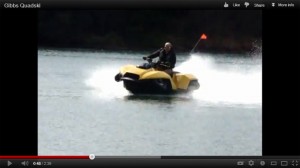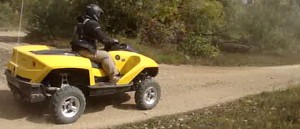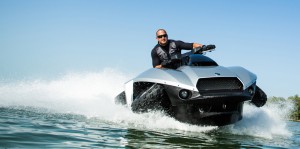
The Gibbs Quadski is the world's first production fast amphibian. Capable of 45 mph on land or water, the Quadski can transition between the two in as little as five seconds.
We fire up the Gibbs Quadski – the world’s first production, planing fast amphibian – and head straight for the water. Just as the tires start to get wet, we instinctively grab the brake lever because, well, wheeled vehicles aren’t supposed to go in the water.
But then we remember that this wheeled vehicle is different. In fact, that the Quadski can roll into the water is precisely what makes it special.
As a Gibbs marketing representative said, “that’s when the magic happens.”
After pushing a button to raise the wheels – the key feature that transforms the Quadski from land vehicle to boat – we squeeze the throttle lever and in as little as five seconds after entering the water, we’re on plane.
Gibbs, founded by New Zealand industrialist Alan Gibbs, has been developing what it calls High Speed Amphibian technology for 15 years. But after teasing enthusiasts for years, it is finally going to start making one of them.
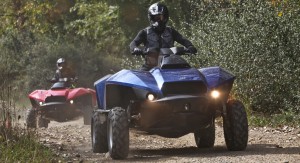
On land, the Quadski limits power since an all-terrain vehicle requires less power than a personal watercraft, where the Quadski uses the engine's full 175 horsepower.
Forty-five miles per hour in the water, the same on land. And a transition between the two in as little as five seconds. That’s what Gibbs has said the Quadski would do and finally is ready to deliver after years of promises and premature production plans.
A year ago, we had a chance to take a quick spin on a Quadski prototype and came away thinking that it needed more pop “out of the hole.” Problem solved. Gibbs completely redesigned the jet and impeller, making it bigger to provide more thrust.
Now, the Quadski feels powerful from rest. It gets on plane quickly and easily achieves top speed. Power comes from a 175-horsepower 1.3-liter four cylinder lifted straight out of a BMW K1300 motorcycle.
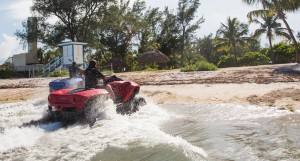
The key to the Gibbs Quadski is its ability to seemlessly transition between water and land in as little as five seconds.
The ride is smooth and the Quadski feels well balanced, although our test drive was on a mirror-smooth lake, so we can’t say how well it handles rough water. It carves smooth turns, although the shallow vee of its hull means it doesn’t turn as well as the best-handling personal watercraft.
One of the most controversial aspects of the Quadski is Gibbs’ insistence that it doesn’t need four-wheel drive. Will the Quadski be able to hoist itself out of the water on slick or steep transition zones? Unfortunately, our test didn’t include any difficult spots on which to test the Quadski.
Gibbs says that rear-wheel drive – with a limited-slip differential – combined with the jet are plenty to push the Q up any suitable landing.
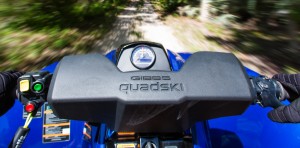
The Quadski has a large speedometer, but the tach is in a small LCD screen. A six-speed BMW motorcycle transmission is shifted with a toggle button on the left handlebar. A thumb throttle is on the right handlebar. Because the BMW transmission has no reverse, the Quadski uses an electric motor to provide reverse.
Now, let’s check out the other half of the Quadski equation. It’s time to put the wheels back down and see what it can do on the trails. As easy as it is to go in the water, it’s just as easy to exit. After coming off plane, toggle the wheels down. Since the jet is always engaged, we can still power through the water until the wheels catch ground and help propel the vehicle out of the water.
ATVs require far less power than PWCs, but the Quadski uses the same 1.3-liter BMW four cylinder nestled under the seat for motivation on land. At one point Gibbs said its solution was to cut engine power while on land to 20 percent, but it is not currently publicizing that number. How much horsepower does the engine produce on land? The company won’t say.
Despite the cut in power, the Quadski accelerates quickly and easily hits its 45 mph top speed. Even with the limited-slip diff and the reduced power output, the Q still willingly kicks out its tail end under power.
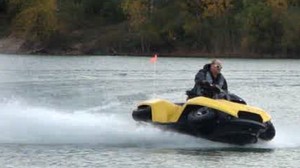
The Quadski feels stable on water and turns smoothly. The tires tucked into the wheel wells on water do not impact the way the Q handles.
The ride is very smooth and the single-seat Quadski always feels stable. At 126 inches in length and 63 inches wide, it ought to.
Gibbs uses BMW’s constant-mesh six-speed manual transmission, but mounts its own automated clutch. Shifting is by a toggle switch on the left handlebar. There is no full automatic mode. Computers prevent the operator from over-revving the engine.
Does a vehicle with a 45-mph top speed need a six-speed tranny? Not really. Three would be plenty. In water mode, the Q uses third gear.
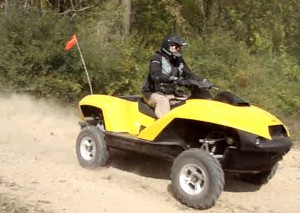
While the first Quadski is a single seater, versions that can seat more than one person are likely in the future.
Gibbs has been using a Polaris Sportsman 800 as a chase vehicle at its test site. The smaller Sportsman’s engine makes 54 horsepower and doesn’t feel as quick as the Quadski, suggesting the Gibbs machine is probably producing about 80 horses while on land.
Many buyers will be tempted to try to eliminate the governor and coax the full 175 horses out of the engine on land. Better get an advanced computer-engineering degree, because you’re going to need it. Gibbs Chairman Neil Jenkins described the Quadski as tamper-proof.
The cut in power does not stop the fun on land. Even with a limit-slip diff, the Quadski allows a little tail-out antics in turns.
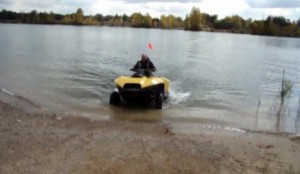
"That's when the magic happens," a Gibbs marketing rep said about the Quadski's transition from boat to land vehicle.
Here’s what the Quadski is not: It is not the ultimate rock hopper ATV. And it’s also not going to out-handle the most extreme personal watercraft. But it is a better ATV than any other PWC and it is a better PWC than any other all-terrain vehicle.
Criticisms? The Quadski features a single large dial for speed with an LCD readout in the lower right corner for other information such as tachometer and gear number. The LCD is virtually unreadable while moving. Gibbs officials said production versions would have a more legible LCD, but it’s still too small to see easily. A separate analog tachometer would be more useful.
Then again, even making reduced power on land, the Quadski is rarely wanting for power, so being in just the right gear isn’t all that important.
Also, there are several exposed screws on the body. While it’s a matter of taste, the Quadski would look better with hidden fasteners.
But nothing detracts from what the Quadski represents. Instead of having an ATV and a PWC, you can now have one vehicle that is both.
Without getting off the vehicle, you can go from fishing in the middle of the bay to riding the trails. Instead of leaving your PWC at the beach of a remote island, go farther on a Quadski. Forget the trouble of trailering and launching a PWC, you can drive into the water right at the beach. Instead of storing an ATV and a PWC on a trailer, you store one vehicle.
While the exact price has not been set, Gibbs said it will be “about” $40,000. The company will begin taking orders at gibbssportsamphibians.com next week. Deliveries will begin in November.
Now here’s the problem for everyone who doesn’t live in the eastern United States. With a plan to build just 1,000 of the machines in the first year, Gibbs will limit sales to just five or six dealers, all of which will be east of the Mississippi River. It expects to have as many as 20 dealers within a year.
As a new manufacturer building a product unlike anything else in existence in a new factory, the company wants to make sure the Quadski performs up to expectations before it ramps up production to 5,000 to 6,000 per year. The price is likely to come down as the company realizes economies of scale. How far could the price come down? Gibbs would like to get the price to the high 20s.
Gibbs has been working on its High Speed Amphibian technology for 15 years. After years of broken promises and $200 million in development costs, the company is finally ready to put one of its amphibians into production.
The Quadski is just the start. The company is also taking orders for its Phibian, a 30-foot amphibian aimed at first responders. Variations on the Quadski are also expected.
Click here to read about the Phibian.
And, once it can clear more significant regulatory hurdles, the company will build an amphibious car, called the Aquada. In fact, the company originally developed its HSA technology for the Aquada, but decided to focus on other vehicles while the Aquada is mired with regulatory problems related to fundamental problems that make it impossible to meet all government regulations at the same time.
Click here to read more about how the Quadski could help the Aquada become a reality.
Click here to read how lawyers representing the company are trying to get the government to recognize a new type of road-going vehicle – amphibians.
Bryan Laviolette is the founder and editor of FastAmphibians.com. Follow him on twitter @FastAmphibians.

